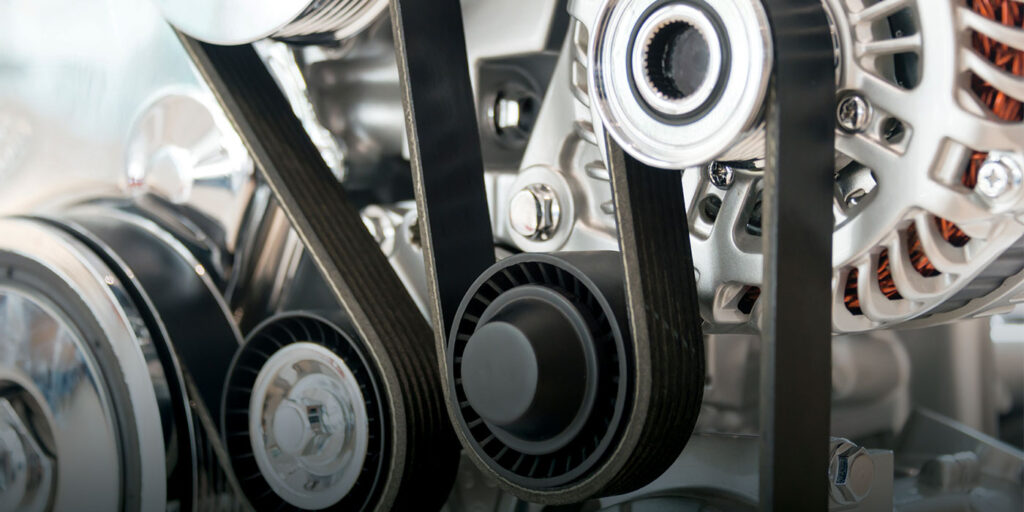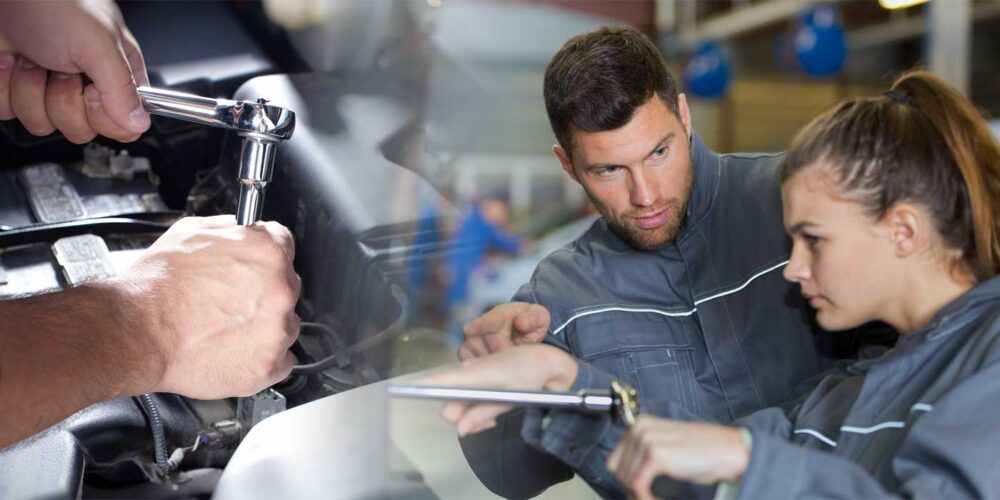Have you ever seen one of those movies where all of the main characters are the same actor or actress? In some cases, the makeup and acting is done so well, you don’t even know it’s the same person. They have a lot of roles, and you don’t even know what they all are!
If you could liken this to an automotive application, it would be tensioners and pulleys. They play a lot of roles, and we often don’t know – or sometimes just don’t think about – what they are. We take them for granted.
We’ll start with pulleys, since they’re just about as old as any other automotive part in existence. For years (and still for the most part), pulleys were just a static piece of metal. In other words, they were boring. They simply gave belts a place to sit in order to transfer power from the crankshaft to the accessories that were mounted on the engine, such as the alternator, water pump, air-conditioning compressor or power steering, just to name a few.
While they seemed like such a simple device, there always has been a lot more behind the scenes. There are two basic types of pulleys: a V-belt pulley and a serpentine-belt pulley. There also are toothed pulleys that are associated with timing belts or chains, but I’m just going to focus here on the pulleys that are external to the engine.

Pulley Size
Regardless of the type of pulley, one of the first things that goes into the design of a pulley is its size. Think of them like the gearing on a typical 10-speed bicycle. When you need more power, you shift gears, so the chain is on the small sprocket in front and the large sprocket at the rear wheel. The pedals spin fast and easy and you have the power to go up a steep hill, but you don’t get anywhere quickly.
Conversely, when you want to go faster, you shift so the chain is on the large sprocket in front and the small one at the rear wheel. This is where you get your speed, but it takes a much greater effort from you to do it.
So, the size of each pulley has a considerable effect on how fast engine accessories spin. The larger the crankshaft pulley, the faster they all spin, but more power is required from the engine to do it. Accessory pulleys are the opposite. The larger the accessory pulley, the slower that accessory spins, but it draws less power from the engine.
This is important because each different type of accessory is designed to operate at a certain speed to perform its intended job. To illustrate this, let’s consider an engine running at idle speed and look at alternator operation. Have you ever been in a car at night that when idling, the lights are dim, but as soon as you accelerate, they get bright? The alternator wasn’t spinning fast enough to generate the necessary electrical output. Either the idle speed is too low, or the electrical consumption is too high.
Using this example, when a vehicle is designed, the alternator pulley is sized so that it spins fast enough at idle for the battery to charge properly. If you add electrical accessories like fog lights or a powerful stereo, you may experience low charging at idle, and installing a smaller pulley to increase the speed of the alternator could solve the problem. But, then you have to consider how fast the alternator spins at high engine rpm. On a high-revving engine, it’s very possible that you could spin an alternator in excess of its mechanical limits. Alternators can spin very fast without problems, but when you exceed 16,000 to 17,000 rpm, you could be knocking on the door for trouble.
To further illustrate this in design, many performance cars in the past have utilized larger alternator pulleys for two reasons. One, so they didn’t spin too fast at high rpm; and two, so they consumed less power from the engine. Of course, we could open a can of worms on the subject of alternators, but we’ll leave it closed for now. They work as a good example. The same principle is true for any accessory driven by the engine.
The second aspect of pulley design is the relationship between the belt and the pulley. V-belt pulleys seem simple, but they are different widths, designed for different-width belts. Using the correct belt is important, because if you consider the cross-section of each, the belt and pulley must make sufficient contact, or there won’t be good grip between the two and the belt will slip.
Another aspect of the V-belt pulley is the depth of the groove. Performance vehicles that were expected to see higher rpm typically would feature pulleys with deeper grooves to prevent the belt from jumping out. This leads us to many of the drawbacks of a V-belt system. The contact area between the belt and pulley was often small, leading to squealing and slipping, and the belts themselves were more susceptible to stretch.
V-belts required regular adjustment and more frequent replacement, slipping and squealing was common and pulley misalignment often led to noisy belts or belts that jumped off. Part of this problem was related to the fact that most engine-mounted accessories were done so via stamped-steel brackets and there was a lot of flex that naturally occurred. Technicians spent many years battling the V-belt system, and when automotive design began to switch to serpentine-belt technology, it was a welcome change.
Serpentine Belts: An Instant Improvement
The relationship between the serpentine belt and pulley brought an instant improvement in belt performance, providing a much greater contact area. Although serpentine belts would stretch to a certain degree, it was not near the same extent as a V-belt, so maintenance was a lot less.
Serpentine belts were not immune to noise complaints, and they were even more susceptible to it from even the slightest pulley misalignment. One of the big improvements that came around quickly at this time was the mounting of the driven accessories. Flimsy stamped-steel brackets were disappearing, and cast-steel or aluminum brackets took their place, offering solid mounting points, creating laser-straight pulley alignment.
Another cause of noise from serpentine belts stemmed from the slapping of a belt that spanned a longer distance. This problem (one that occurs with all belts, serpentine or V) is the result of the tension changes on a belt during engine acceleration and deceleration. Under acceleration, the belt is pulled tight on the side leading to the crank pulley, but slack forms following the crank pulley. This reaction of the belt reverses under deceleration. Not only can this cause noise, but also vibration, and it can cause additional wear on the belt and driven accessories.
Even though this caused noise in either type of belt, it was more audible with a serpentine belt due to its width. This is where two different types of functional pulleys come into play: the idler pulley and the tensioner pulley.
Idler pulleys are used for the purpose of supporting a belt across a long span or guiding it to change direction where there’s no accessory to perform the task. Idler pulleys, depending on which side of the belt they are located, either will be grooved to match the belt (V or serpentine), or they will be smooth. Since idler (and tensioner) pulleys aren’t driving an accessory, they ride on a bearing.
Tensioners: Automatic and Manual
While idler pulleys help reduce the effects of acceleration and deceleration, they don’t completely solve the issue – but the automatic tensioning pulley does the job. Normally, they’re referred to simply as tensioning pulleys or belt tensioners. I’m using the term “automatic” here in order to clarify the difference between a manually adjustable tensioner.
Manual tensioners, used on both serpentine and some V-belts, are just an idler pulley that’s mounted onto an adjustable base. A threaded bolt goes through the base, and the head of it is supported by a bracket. The belt-tension adjustment is made by tightening or loosening the belt, depending on application. While it’s an effective method and often much easier than the traditional “swing” of an entire accessory to take up slack, it doesn’t solve accel/decel effects, and it still leaves the age-old problem of manual belt adjustment, getting it too tight or not tight enough.
The second type of tensioning pulley continuously and automatically keeps belt tension at its optimal point and, as mentioned before, is really what we refer to when we say “tensioner” or “tensioning pulley.” It’s simply an idler pulley that is mounted on a bracket, which, in turn, contains a spring mechanism that applies a constant, predetermined amount of tension on the belt. This type of tensioner eliminates noise, regular belt adjustment and over- or under-tightening of the belt, and reduces harsh effects on accessories from accel/decel forces.
Special Pulleys
Many new vehicles have special alternator pulleys that are either overrunning alternator pulleys (OAP) or overrunning alternator decouplers (OAD). The purpose of both is to reduce any remaining noise, vibration or harshness (NVH) that’s associated with a serpentine belt. An OAP works through a one-way clutch mechanism located in the hub. It drives the alternator in one direction, but under rapid deceleration it allows the pulley to freewheel so the alternator will spin free on its own.
An OAD works in the same manner, with the added feature of internal vibration dampers to absorb harmonic vibrations in the belt and reduce noise.
Idler pulleys have earned a unique position over the years of occasionally being a replacement for bad A/C compressors. With some higher-production vehicles that see frequent compressor failures when they get old, many owners opt not to spend the money to fix them. But, without the pulley from the compressor, the serpentine belt loses its running path. An idler pulley for this application will be designed with its own mounting bracket that uses the same mounting bolts for the compressor, and the pulley is the same size as the original compressor pulley.
Performance pulleys are a very common upgrade on newer vehicles with serpentine-belt drive systems. One modification is weight. A lighter-weight pulley translates to less rotational weight, which means an engine can build speed quicker. Larger or smaller pulleys are used to reduce or increase the speed of accessories, as we mentioned earlier, but a very popular one today is to get a smaller supercharger pulley, which increases the speed and boost for increased power.
As with a lot of performance modifications, when increasing or decreasing pulley size to attain a certain result, it can have an effect on other engine-operating aspects. Companies that offer different-sized pulleys are well-aware of it and do a good job at clearly describing any other modifications that need to be done in conjunction with a pulley change.
Serpentine-belt systems are without a doubt more enjoyable than V-belt systems due to their dependability and lower maintenance. For this reason, most of the V-belt systems on popular older engines can be replaced with a serpentine-belt system that’s readily available in a kit. It’s not uncommon to see this conversion on old classic or muscle cars. We’ve been spoiled by the serpentine belt.
So, you can see that tensioners and pulleys play a huge part in engine and accessory operation. For a round piece of metal that doesn’t seem like it would do much, other than support a belt, they play a surprising number of roles.














